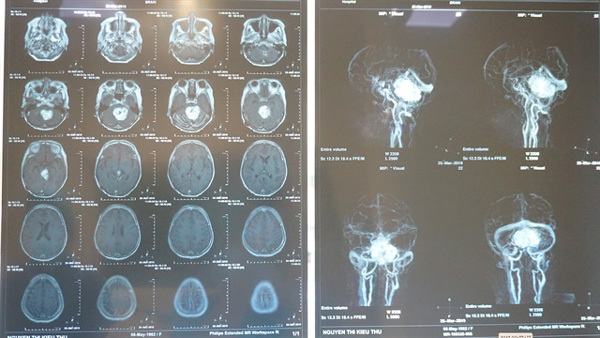Vietnamese doctors conducted first-ever awake brain tumor surgery
HCM City: doctors remove large tumour from infant
 |
| The patient’s MRI showed brain stem glioma. Photo courtesy of the City International Hospital |
The patient from the city’s District 6 had been admitted to the hospital in Binh Tan District on March 8 with paralysis of her right side, drooping left eyelid, lower cranial nerve palsies, and incontinence.
Her physical examination was unremarkable. She was alert, interactive, oriented, and able to answer questions appropriately.
Three years ago she had been diagnosed with hemangioblastoma, which are benign and highly vascular tumors in the left temporal lobe.
An emergency surgical intervention was done for intramedullary hematoma, or an abnormal collection of blood outside of a blood vessel and tumor.
She developed post-operative hydrocephalus, or a build-up of fluid in cavities deep within the brain, and she was placed on a ventriculoperitoneal shunt, a medical device that relieves pressure on the brain caused by fluid accumulation, for three months in March last year.
But an imbalance between the intra- and extra-cranial pressures led to excessive drainage, and she has suffered from cognitive disorders and extremity weakness since then.
When hospitalised this time, doctors prescribed a blood analysis, biochemical analyses and an MRI investigation of the brain.
A pathological examination confirmed the diagnosis of hemangioblastoma in the left temporal lobe and the need for emergency surgical intervention. The surgery was done on March 31.
Dr Huynh Hong Chau, head of the hospital’s neurosurgery department, said: "This case of adult malignant grade- IV brain tumor is extremely challenging and life expectancy is very low.”
The surgery to remove a giant tumor used intra-operative computed tomography image-guided navigation (Navigation).
Several surgical techniques and technological innovations have been introduced recently to help surgeons achieve maximal safe resection of tumours while reducing the odds of post-operative complications, Chau said.
Neuro-navigation has become a common tool in the surgical management of brain tumours.
It helps surgeons navigate and locate brain tumours relative to the position of the skull.
Accurate positioning of the skin incision and the opening of the skull and clearly distinguishing between tumour margins and the surrounding tissue help remove tumors least invasively and with limited brain damage, especially in case of tumors deep in the brain.
The patient’s health has been improving, the hospital said.
VNS
 Surgeons at HCM City’s City International Hospital successfully performed a 15-hour cerebrovascular surgery on a 57-year-old woman recently to remove a grade-IV brain tumor.
Surgeons at HCM City’s City International Hospital successfully performed a 15-hour cerebrovascular surgery on a 57-year-old woman recently to remove a grade-IV brain tumor.